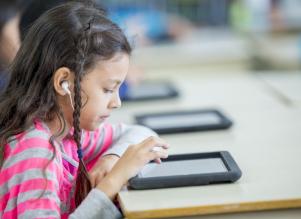12/11/2017
The Importance of Increasing Access to Digital Learning Tools
As technology becomes increasingly essential in our daily lives, students need to develop new skills in order to succeed. Within the classroom, students may be required to use tablets, complete online research, and take digitized assessments. In day-to-day life outside the classroom, students are inundated with information and opportunities available online—but many lack the access or skills to use these resources.
Experts have coined a term for this tech-savvy knowledge: Digital literacy. Digital literacy may become the new buzzword in education as parents and educators alike work to help students prepare for a world that is increasingly online. But what exactly is digital literacy? Why are some students struggling to learn these skills, while others come to school with as much—if not more—technological know-how as their teachers? And perhaps most importantly, how can educators close this digital literacy gap?
What is digital literacy?
For educators seeking to define the importance of technology in the classroom, the library at the University of Illinois at Urbana-Champaign is a resource that works closely with librarians and faculty. The University Library notes that digital literacy involves a plethora of skills: “Literacy includes the ability to read and interpret media, to reproduce data and images through digital manipulation, and to evaluate and apply new knowledge gained from digital environments.” In short, digital literacy is defined not only by the ability to use technology to read and write, but by the ability to use it effectively.
Although digital literacy is clearly important in many aspects of modern life, not all students have equal access to technology. As educators make strides in bringing online reading resources into their classrooms, it has become clear that some students have a steeper learning curve in achieving digital literacy.
A double disadvantage
In terms of digital literacy, students from low-income households are at a disadvantage compared to their more affluent peers. According to a 2013 Pew Research study, 39 percent of Advanced Placement and National Writing Project teachers of low-income students believe their school is "behind the curve" when it comes to effectively using digital tools in the learning process. In contrast, just 15 percent of those teaching higher-income students rate their schools poorly in this area. According to the same study, "56 percent of teachers of the lowest-income students say that a lack of resources among students to access digital technologies is a 'major challenge' to incorporating more digital tools into their teaching; 21 percent of teachers of the highest-income students report that problem."
This disparity between high- and low-income students leads to additional challenges in the classroom, as low-income students also have less access to books and print material in their homes compared to their high-income peers. If some students are able to read and use the internet for school projects in their homes while others only have access to these resources at school, the literacy gap—both print and digital—will continue to widen.
Closing the (digital) literacy gap
While the gap between high- and low-income students’ access to newer technology is apparent, so too are the efforts to fix it. According to a 2014 Stanford Center for Opportunity Policy in Education paper titled Using Technology To Support At-Risk Students’ Learning, “The good news is that research shows that if at-risk students gain ready access to appropriate technology used in thoughtful ways, they can make substantial gains in learning and technological readiness.”
For years, various education and charitable organizations have provided print books to low-income students to help close the literacy gap. Now, the same method is being applied to help disadvantaged students access technology in their homes. On the national level, President Obama widened his ConnectEd initiative to bring high-speed internet to K-12 schools and libraries by introducing the ConnectHome expansion in 2015. The pilot program proposed to bring the internet—and the literacy resources it provides—to low-income American families by providing broadband, tech training, digital literacy, and new devices to residents in assisted housing, including nearly 200,000 children.
Individual school districts can help, too. For instance, Washington state's Kent School District provides laptops to each of its students in the seventh grade and higher, and allows students without at-home online access to do their homework at "internet kiosks." Within the classroom, educators can provide one-to-one access (one device per student) to help support students who are at a disadvantage for learning technological skills. According to the Stanford Center for Opportunity Policy in Education paper, “Researchers have found that one-to-one availability is particularly important for lower-income students’ ability to gain fluency in using the technology for a range of learning purposes, since they are less likely to have these opportunities at home.”
For low-income students, using technology in the classroom can create an additional hurdle to learning if they are not already familiar with using technology at home. By helping low-income families access the internet and technological devices and providing one-to-one technology access at school, educators can help bridge the digital literacy gap. As we move further into the digital age, dual literacy in print and technology is the key to success for our students, both inside and outside the classroom.


